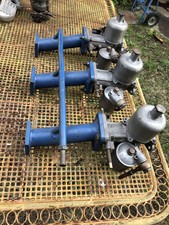Here is what I am dealing with. Looking for all ideas!
Hi XXXX
I spoke with you on the phone about a month ago concerning the Carter AS on my 1963 Studebaker that (great company) remanufactured about 5 or so years ago. It's been running very rich, and always has. What I sent was a carb with no tags on it, so it is/was a mongral.
You were unhappy with the Pertronix ignition I installed and suggested that was the issue. I reinstalled a used, but not badly worn distributor with points, new non-resistor plugs, but retained the 40kV coil, wires, and cap. I verified correct voltage and resistance to the coil. There was no change whatsoever.
I spoke with Dave Thiebault (sp) about it, and installed an old RBS that I had used, but never was happy with. The rich running went away, but power is way down.
Dave suggested that the engine modifications may be an issue: The engine was originally a Studebaker 170 OHV. It was rebuilt with a crank from a 185 flathead, increasing the compression as well, and a somewhat mildly modified cam with .305” gross lift (I&E), 225 degrees duration @ .50, .460” valve lift and 288 degrees duration at running clearances.
Given this mix, does the carb need re-jetting, and to what? Or can you suggest something better as a carb? Please help me get this running as it should.
Thank you!
What do you all say here?
Hi XXXX
I spoke with you on the phone about a month ago concerning the Carter AS on my 1963 Studebaker that (great company) remanufactured about 5 or so years ago. It's been running very rich, and always has. What I sent was a carb with no tags on it, so it is/was a mongral.
You were unhappy with the Pertronix ignition I installed and suggested that was the issue. I reinstalled a used, but not badly worn distributor with points, new non-resistor plugs, but retained the 40kV coil, wires, and cap. I verified correct voltage and resistance to the coil. There was no change whatsoever.
I spoke with Dave Thiebault (sp) about it, and installed an old RBS that I had used, but never was happy with. The rich running went away, but power is way down.
Dave suggested that the engine modifications may be an issue: The engine was originally a Studebaker 170 OHV. It was rebuilt with a crank from a 185 flathead, increasing the compression as well, and a somewhat mildly modified cam with .305” gross lift (I&E), 225 degrees duration @ .50, .460” valve lift and 288 degrees duration at running clearances.
Given this mix, does the carb need re-jetting, and to what? Or can you suggest something better as a carb? Please help me get this running as it should.
Thank you!
What do you all say here?
 (and I have other postings that prove I'm not an expert.
(and I have other postings that prove I'm not an expert. ) If I was all that good, all of my vehicles would be perfect, sadly, none of them are.
) If I was all that good, all of my vehicles would be perfect, sadly, none of them are.



Comment